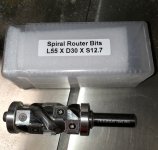rmwarren
Member
- Joined
- Jul 11, 2010
- Messages
- 3,063
I'm serious thinking about splurging on one of these bits even though I don't have an immediate use. I'd been idly considering the larger diameter import version but this looks even better.
Where I'm unsure is whether to go whole hog and get the 2" bit, which I'll likely never need (but always prefer to have the option for more/bigger...), or stick with the 1-1/2". The only downside I see to the longer bit is it might have a slightly higher potential for chatter. What am I missing?
I don't have a project for either bit now, just looking to take advantage of the intro price and have it available when needed.
Thoughts?
RMW
Where I'm unsure is whether to go whole hog and get the 2" bit, which I'll likely never need (but always prefer to have the option for more/bigger...), or stick with the 1-1/2". The only downside I see to the longer bit is it might have a slightly higher potential for chatter. What am I missing?
I don't have a project for either bit now, just looking to take advantage of the intro price and have it available when needed.
Thoughts?
RMW


